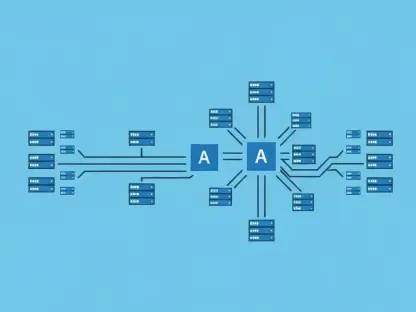In the fast-paced world of software development, test automation serves as a crucial lifeline, enabling rapid releases and robust validations, but what happens when the very tools designed to ensure software quality become a backdoor for catastrophic breaches? Beneath the surface of scripts and pipelines lies a silent threat: exposed secrets. Hardcoded credentials in test code or environment files are more common than many teams realize, turning routine automation into a potential security disaster. This hidden vulnerability demands attention, as the cost of a leak can be devastating to both reputation and resources.
The Alarming Reality of Exposed Test Secrets
Test automation frameworks like Playwright, Cypress, and Selenium have revolutionized how teams validate applications across platforms. However, a staggering number of these setups harbor a critical flaw—sensitive data such as API keys or database passwords often sit unprotected in plain text within scripts or configuration files. A recent industry report revealed that over 60% of organizations have encountered security issues stemming from improperly managed credentials in non-production environments. This statistic underscores a pervasive oversight in an area often assumed to be low-risk.
Beyond mere numbers, the problem manifests in tangible ways. Many development teams, under pressure to deliver quickly, bypass best practices, embedding credentials directly into code repositories. These secrets, once committed, linger in version history, accessible to anyone with repository access. The assumption that test environments are isolated from real-world threats is a dangerous myth, as these systems frequently connect to live APIs or shared databases, amplifying the potential for damage.
Why Secret Leaks in Automation Are a Big Deal
The consequences of leaked secrets in test automation extend far beyond a minor inconvenience. When credentials are exposed, they can grant unauthorized access to critical systems, leading to data breaches or service disruptions. Consider the case of a major enterprise where a routine audit uncovered plaintext credentials in a test suite’s Jenkins logs, risking exposure of internal APIs to external threats. Such incidents highlight how a single oversight can cascade into a company-wide vulnerability.
Moreover, the impact isn’t limited to security alone. Poor secret management creates operational burdens, especially during credential rotation. A simple password update for a shared database can break numerous test scripts if those credentials are hardcoded, leading to downtime and frantic troubleshooting. This dual threat—security risks combined with maintenance challenges—makes addressing secret leaks an urgent priority for any team relying on automation.
Unpacking the Ways Secrets Slip Through the Cracks
Understanding how secrets become exposed in automation pipelines is critical to preventing leaks. One common pitfall lies in version control systems like Git, where secrets committed to a repository remain retrievable in historical commits, even after deletion from current files. This persistent exposure often goes unnoticed until a breach occurs or an audit flags the issue, leaving teams scrambling to mitigate the damage.
Another frequent issue arises in CI/CD tools such as GitHub Actions or Jenkins, where build logs can inadvertently display unmasked credentials during failed jobs. Additionally, test code often evades the rigorous security scans applied to production systems, creating blind spots in DevSecOps processes. Compounding these risks, developers may copy and reuse scripts across projects, unintentionally spreading hardcoded secrets. These interconnected vulnerabilities illustrate why traditional storage methods are inadequate for safeguarding sensitive data in automation workflows.
Expert Insights on Locking Down Automation Secrets
Security professionals and industry leaders consistently warn against treating secrets management as an afterthought in test automation. HashiCorp, the developer of Vault, advocates for dynamic secrets as a cornerstone of zero-trust architecture, ensuring credentials remain temporary and protected. This perspective is echoed in real-world experiences, such as a tech team discovering leaked API keys in public CI logs during a compliance review, prompting an immediate overhaul of their secret handling practices.
These expert opinions and case studies reveal a consensus: centralized secrets management is no longer optional but essential. Adopting tools that enforce strict access controls and eliminate static credentials aligns with modern security standards. This shift not only prevents leaks but also builds a foundation of trust and accountability within development pipelines, a necessity as cyber threats continue to evolve.
Securing Automation with HashiCorp Vault: A Practical Guide
HashiCorp Vault offers a robust solution to eliminate the risks of exposed secrets by enabling dynamic credential management in test automation. The first step involves setting up Vault to store sensitive data in secure paths, such as secret/data/test/app-login, with access restricted through granular policies. This ensures that only authorized services or pipelines can retrieve the necessary credentials, minimizing exposure.
Next, authentication within CI/CD workflows can be achieved using methods like AppRole, allowing pipelines to obtain short-lived tokens for secret access. During test execution—whether for UI testing with Playwright or API validation with RestAssured—secrets are fetched at runtime and injected directly into scripts, avoiding any static storage in code or environment files. For Jenkins users, Vault’s dedicated plugin simplifies this process by securely passing credentials like database passwords into pipeline stages, ensuring they never appear in plain text.
The advantages of this approach are manifold, including enhanced security, effortless credential rotation, and comprehensive audit trails. Teams can start by securing a single high-risk test suite, addressing challenges like token expiry with retry mechanisms, and educating developers to abandon outdated practices. By integrating Vault, automation pipelines become not only safer but also more scalable and compliant with regulatory demands.
Reflecting on a Safer Path Forward
Looking back, the journey through the perils of secret leaks in test automation revealed a landscape fraught with hidden dangers, from version control mishaps to logging oversights. Each misstep carried the potential to unravel even the most sophisticated testing frameworks, exposing critical systems to unauthorized access. The real-world examples and expert guidance underscored the urgency of addressing these vulnerabilities head-on.
The adoption of solutions like HashiCorp Vault proved to be a game-changer, transforming how teams approached credential management with dynamic, secure practices. Moving forward, the focus should remain on building awareness around secure automation habits, starting with small, actionable steps like auditing existing pipelines for exposed secrets. Embracing centralized secrets management ensures that test environments are no longer weak links but fortified components of a resilient software delivery process.









